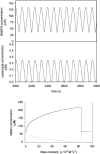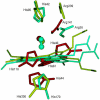Concerted simulations reveal how peroxidase compound III formation results in cellular oscillations
- PMID: 12944259
- PMCID: PMC1303318
- DOI: 10.1016/S0006-3495(03)74574-3
Concerted simulations reveal how peroxidase compound III formation results in cellular oscillations
Abstract
A major problem in mathematical modeling of the dynamics of complex biological systems is the frequent lack of knowledge of kinetic parameters. Here, we apply Brownian dynamics simulations, based on protein three-dimensional structures, to estimate a previously undetermined kinetic parameter, which is then used in biochemical network simulations. The peroxidase-oxidase reaction involves many elementary steps and displays oscillatory dynamics important for immune response. Brownian dynamics simulations were performed for three different peroxidases to estimate the rate constant for one of the elementary steps crucial for oscillations in the peroxidase-oxidase reaction, the association of superoxide with peroxidase. Computed second-order rate constants agree well with available experimental data and permit prediction of rate constants at physiological conditions. The simulations show that electrostatic interactions depress the rate of superoxide association with myeloperoxidase, bringing it into the range necessary for oscillatory behavior in activated neutrophils. Such negative electrostatic steering of enzyme-substrate association presents a novel control mechanism and lies in sharp contrast to the electrostatically-steered fast association of superoxide and Cu/Zn superoxide dismutase, which is also simulated here. The results demonstrate the potential of an integrated and concerted application of structure-based simulations and biochemical network simulations in cellular systems biology.
Figures





Similar articles
-
Computational, pulse-radiolytic, and structural investigations of lysine-136 and its role in the electrostatic triad of human Cu,Zn superoxide dismutase.Proteins. 1997 Sep;29(1):103-12. doi: 10.1002/(sici)1097-0134(199709)29:1<103::aid-prot8>3.0.co;2-g. Proteins. 1997. PMID: 9294870
-
Evolutionary constraints for dimer formation in prokaryotic Cu,Zn superoxide dismutase.J Mol Biol. 1999 Jan 8;285(1):283-96. doi: 10.1006/jmbi.1998.2267. J Mol Biol. 1999. PMID: 9878406
-
The role of arginine 143 in the electrostatics and mechanism of Cu,Zn superoxide dismutase: computational and experimental evaluation by mutational analysis.Proteins. 1994 May;19(1):24-34. doi: 10.1002/prot.340190105. Proteins. 1994. PMID: 8066083
-
Superefficient enzymes.Cell Mol Life Sci. 2001 Sep;58(10):1451-60. doi: 10.1007/PL00000788. Cell Mol Life Sci. 2001. PMID: 11693526 Free PMC article. Review.
-
Probing the structural basis for enzyme-substrate recognition in Cu,Zn superoxide dismutase.Free Radic Res Commun. 1991;12-13 Pt 1:287-96. doi: 10.3109/10715769109145797. Free Radic Res Commun. 1991. PMID: 1649096 Review.
Cited by
-
Combining hypothesis- and data-driven neuroscience modeling in FAIR workflows.Elife. 2022 Jul 6;11:e69013. doi: 10.7554/eLife.69013. Elife. 2022. PMID: 35792600 Free PMC article.
-
Several lines of antioxidant defense against oxidative stress: antioxidant enzymes, nanomaterials with multiple enzyme-mimicking activities, and low-molecular-weight antioxidants.Arch Toxicol. 2024 May;98(5):1323-1367. doi: 10.1007/s00204-024-03696-4. Epub 2024 Mar 14. Arch Toxicol. 2024. PMID: 38483584 Free PMC article. Review.
-
qPIPSA: relating enzymatic kinetic parameters and interaction fields.BMC Bioinformatics. 2007 Oct 5;8:373. doi: 10.1186/1471-2105-8-373. BMC Bioinformatics. 2007. PMID: 17919319 Free PMC article.
-
Rate theories for biologists.Q Rev Biophys. 2010 May;43(2):219-93. doi: 10.1017/S0033583510000120. Epub 2010 Aug 9. Q Rev Biophys. 2010. PMID: 20691138 Free PMC article. Review.
-
Fundamental aspects of protein-protein association kinetics.Chem Rev. 2009 Mar 11;109(3):839-60. doi: 10.1021/cr800373w. Chem Rev. 2009. PMID: 19196002 Free PMC article. Review. No abstract available.
References
-
- Amit, A., A. L. Kindzelskii, J. Zanoni, J. N. Jarvis, and H. R. Petty. 1999. Complement deposition on immune complexes reduces the frequencies of metabolic, proteolytic and superoxide oscillations of migrating neutrophils. Cell. Immunol. 194:47–53. - PubMed
-
- Berglund, G. I., G. H. Carlsson, A. T. Smith, H. Szöke, A. Henriksen, and J. Hajdu. 2002. The catalytic pathway of horseradish peroxidase at high resolution. Nature. 417:463–467. - PubMed
-
- Demchuk, E., and R. C. Wade. 1996. Improving the continuum dielectric approach to calculating pKas of ionizable groups in proteins. J. Phys. Chem. 100:17373–17387.
-
- Elcock, A. H., R. R. Gabdoulline, R. C. Wade, and J. A. McCammon. 1999. Computer simulation of protein-protein association kinetics: acetylcholinesterase-fasciculin. J. Mol. Biol. 291:149–162. - PubMed
Publication types
MeSH terms
Substances
LinkOut - more resources
Full Text Sources
Research Materials

